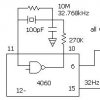bloody-orc
New Member
Hi there
Is there any way and what way to mesure a cristal with a pic. i connect a lets say 27MHz cristal to some pins and then it puls high out 1 but if i put 433MHz cristal to the same pins then it will pull high out nr 2
Is there any way and what way to mesure a cristal with a pic. i connect a lets say 27MHz cristal to some pins and then it puls high out 1 but if i put 433MHz cristal to the same pins then it will pull high out nr 2

